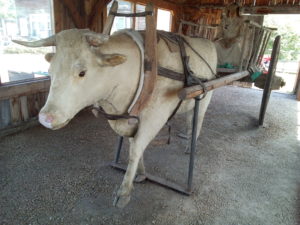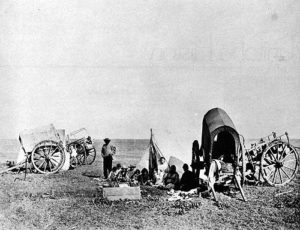
A reconstruction of a Red River Cart now located in Place St. Norbert
Many Métis people were hired by the Hudson’s Bay Company as freighters, tripmen or buffalo hunters. They manned the York boats that took supplies to and from the Hudson Bay as well as other locations serviced by the HBC. Gradually, due to increased rail lines in their territory, the HBC stopped using the boats as the primary method of travel and relied on Red River carts instead.
The first record of a Red River cart was recorded by Alexander Henry the Younger who, in his journal, recorded the process of construction of a Red River cart for use at the Pembina Post. The first cart, made in around 1801 had solid wheels, made from cut logs about three feet in diameter. Starting in 1802, the cart was improved to include wheels with spokes that were dished about 3 inches to increase the strength and stability of the cart. The dished wheels could also be wrapped in canvas, removed and placed under the cart to ferry the cart over water. The cart weighed roughly 550 pounds and could carry 500 pounds when pulled by a horse and more if pulled by an ox.

Métis people with Red River Carts
The carts were made entirely of local wood so that repairs could be easily made without the use of metal or nails and was built using very simple tools such as the hand axe and screw-auger. Grease could not be used in the wheels because it would attract dust and debris and would wear down the wheel axles. For this reason, as well as the lack of metal in the carts, the carts made a characteristic squeal as they travelled across the prairie. The harness was made out of hides, first for the horse and later for an ox. In rare cases, when there was a heavy load and speed did not matter, the cart could be pulled by a team of two horses or oxen.
When on long journeys, these carts would travel in trains or brigades. A brigade consisted of ten carts with three drivers, an overseer, and a guide in front. An ox cart train could span two miles or more. Each of the oxen were tied to the cart in front of them and could travel like this at a rate of about two miles an hour or about 20 miles per day (The Red River Cart and Trails: The Fur Trade).
More than 2500 cart trips were made in service to the Hudson’s Bay Company who used them to transport goods and furs from the Red River Settlement to St. Paul. Starting in 1870, steam boats and trains became more common and the use of the ox cart to transport goods became rare.
In July of 2002, a group of people came together to recreate a cart train and travel from the historical Métis cemetery near Pembina, North Dakota to St. Norbert. Nine carts in total made the trip, 5 of which were built by hand in St. Norbert (Métis Culture & Heritage Resource Centre – Red River Cart Building).
Sources and More Information
The Red River Cart and Trails: The Fur Trade
Métis Culture & Heritage Resource Centre – Red River Métis Cart
Métis Culture & Heritage Resource Centre – Red River Cart Building
Métis Culture & Heritage Resource Centre – Red River Cart Journey
Wikipedia – Red River Cart